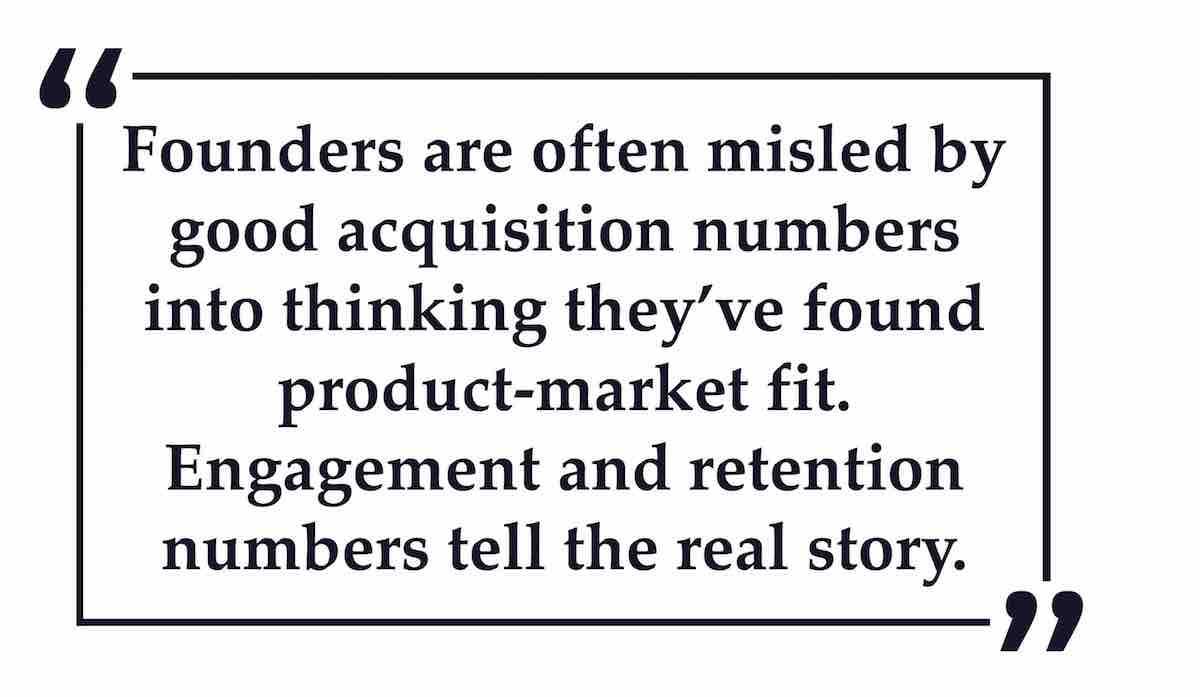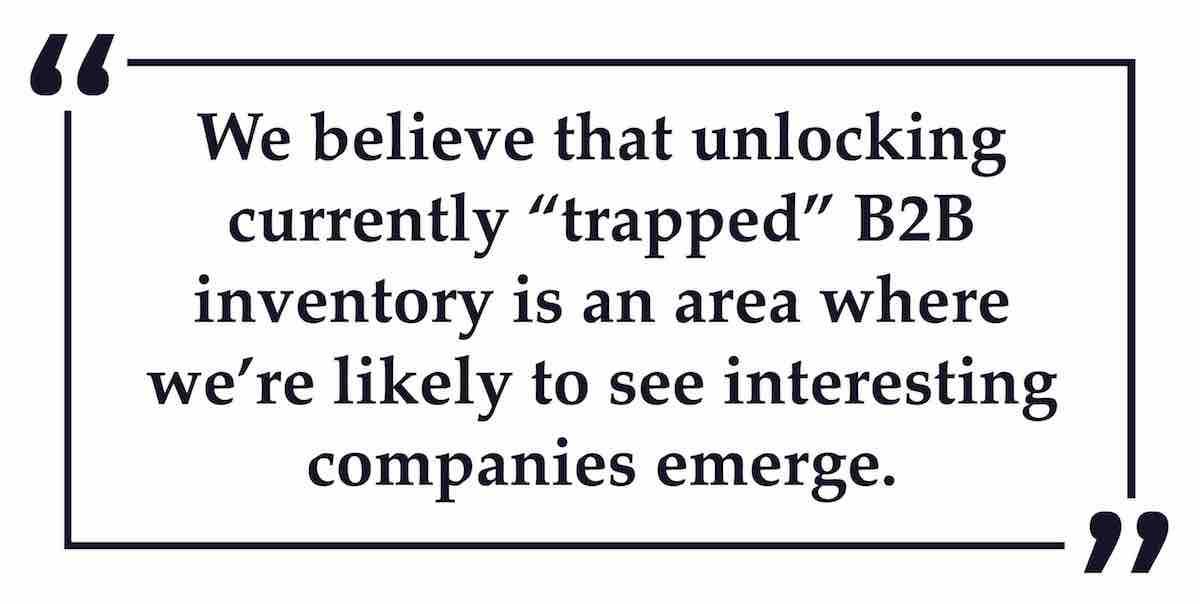

Product-market fit is a prerequisite for sustainable growth. There’s no point in pushing a product which brings no real sustainable value to customers.
Founders are often misled by good acquisition numbers into thinking they’ve found product-market fit (PMF). But just because people are signing up for your product or downloading your app at a low acquisition price doesn’t mean you’ve found PMF.


Engagement and retention numbers will tell the real story. If your product doesn’t have real value for customers, you’re going to see horrible engagement numbers and even worse retention metrics. Real PMF shows up both in user acquisition and in user retention. Top-of-funnel growth means nothing if the users all churn.
If you think about why startups fail, in a way it’s very simple: startups fail because they run out of money before achieving PMF. Like a fighter jet taking off from an aircraft carrier, it’s a simple race between how much runway you have left and how fast you can achieve liftoff.
But once you’ve achieved PMF, failure isn’t as pressing. 99% of the time, once you have real PMF, your startup will have no problem fundraising (at least in the short term) — at which point it becomes more about getting to a faster pace of growth than just survival. It becomes an execution play.
So PMF is the key focus as an early-stage startup. But how do you get there?
The Product-Market Fit Playbook
Much has already been written about the playbook for attaining PMF that you can find in well-known books like Eric Ries’s Lean Startup. The basic theoretical framework is fairly simple. We summarize it as follows:
- Determine who your customers are
- Find their under-served needs or desires
- Define your value proposition
- Specify and build your MVP
- Test it with customers
- Iterate fast till you find product-market fit
Today, we’re going to focus on the second part of this framework, as a follow up to our recent essay on how to come up with startup ideas. In that post, my colleague James Currier discussed some of the frameworks for zeroing in on what makes a good startup idea. Today, I’ll extend the discussion by looking at startup ideas through the lens of PMF.
Where can you find underserved needs or desires?
There are two places that it’s commonplace for Founders to hear they should look for startup ideas. They are told to either a) find a customer pain-point and find a way to relieve that pain, or b) find a potential way to benefit the customer and present them with a “gain creator”.
While that’s not false advice, it’s not complete. It’s too general to be really useful and generate great ideas.
That’s why we’ve developed 10 more specific places where Founders can look for PMF. This is a list that we’ve found very useful in generating ideas as multiple-time Founders ourselves, and today we’re sharing it with the Founder community. The way to use this list is as a sounding board for your startup ideas – to better understand where your idea sits in terms of PMF potential.
1. Taking an existing activity and making it 10X easier
If there’s something people already do that you can make dramatically easier, it’s likely to find product-market fit. You’ve already de-risked from a market standpoint because you have evidence that people actually do the thing your product enables.
The catch is that, for people to adopt it, your product has to make the activity dramatically easier. You have to hit a critical mass of ‘easiness’ to motivate people to switch from their existing habits to start using your product.
DocuSign is a good example. People were already using digital forms of signatures for contracts and other important documents, but DocuSign made it more than 10X easier to do this as compared with faxing or scanning and mailing. Zoom is another recent example: video conferencing have been around for two decades, but the ease-of-use and quality of the Zoom solution got users to simply switch over.
2. Make an existing activity 10X better (& networked)
As with making an existing activity 10X easier, taking an existing activity and making the experience dramatically better — especially if it’s better because you made it a network — is also likely to find product-market fit.
Slack is a great example of this. Water-cooler conversation and chatter amongst employees was already something people did, and various enterprise social-networking and messaging solutions already existed, but Slack made the experience 10X better with its intuitive interface, threading, emoji usage, and other features. It brought the activity of workplace socializing online and made it even more networked by creating versatile clusters like workspaces, channels, and group DMs — all accessed through a seamless signup process using work email addresses.
Slack also shows the benefit of creating a better experience that’s networked at the core level of the product because it makes your traction defensible thanks to the network effects. The 10X better experience you’ve created will get copied, but the network you build using it will be much harder to replicate. For every good idea, you should always ask yourself: ‘how can I create defensibility through network effects?’
3. Create new inventory to be sold in a marketplace
When you find significant new inventory that people couldn’t access before, and you’re able to unlock it for them, you’re likely to see the magic of product-market fit. This was the basic model of companies like Lyft, Etsy, Airbnb, Poshmark, etc. This new inventory adds value to the buyers by making something available that they couldn’t get before. Before Lyft and Uber there were fewer cars to drive you around; before Airbnb sleeping in apartments instead of hotels was hardly possible, inventory was minimal, etc. Likewise, sellers of the inventory often get to monetize assets they could never monetize before, such as their driving time, their used clothes, etc.
My colleague Pete Flint alluded to a similar idea in writing about Fintech-Enabled Marketplaces, where he called it unlocking latent supply. In the case of Fintech-Enabled Marketplaces, the way to create new inventory is by utilizing debt capital. But other online marketplaces, like Poshmark, have been able to unlock new sources of supply by creating a vertical-specific online marketplace and mobilizing supply-side users who hadn’t previously had a distribution platform.
Inventory can be created in any area where assets are being under-utilized, including in a B2B context as with machinery or shipping. We believe that unlocking currently ‘trapped’ B2B inventory is an area where we are likely to see very interesting companies emerge.


4. Discover new willingness to pay
This happens when you do something so well that users will pay for something that they hadn’t previously been willing to pay for.
Get people to pay for things they have mentally classified as “free” obviously isn’t easy. You have to be much better than the free alternative for them to be willing to do it.
But it’s also not as difficult as you might think to discover a new willingness to pay. Zynga was an early example. There were already ways to play poker online for free (with fake currency), but Zynga came up with the idea to charge real money for in-game chips — and people were willing to do it because the experience was good enough to entice them. The act of paying real money for this virtual currency is what made it valuable (though cheaper than playing poker for real money) —- giving a poker game with virtual stakes some of the same excitement as a real-money game.
My company Playtika, for another example, had a slot machine game where you pay money to play the game, but unlike in a real casino, you can’t win any money. When the Founder came up with the idea for this game, I was initially very skeptical. But the product was so good and psychologically compelling that the game ended up making literally billions of dollars.
Discover a new willingness to pay, and it’s fertile soil for finding product-market fit.
5. Connect a group of people that were not visibly connected before
This is getting harder to do as we go deeper into the era of social networks, but if you can find ways to connect new, previously disconnected communities of people, it’s often very fruitful.
This is what we’ve seen for vertical-specific social networks like LinkedIn (professionals), Github & Stackoverflow (developers), MapMyRun (runners), etc. Bringing communities together creates real value, and products that create real value tend to find product-market fit. This requires understanding the emotional drivers of the target audience and delivering them features which they can’t get in the more ‘general’ social networks.
6. Give people a new or easier way to make money
If you can actually fulfill the promise of making money for your users, they’ll love your product. It’s especially relevant if your users are individuals or SMBs, as for enterprise users it’s harder to attribute making more money to your product (and sometimes enterprise users care less about the organization’s overall financial wellbeing).
For example, when people first realized they could make real money driving for Uber and Lyft, the pace in supply-side growth went up astronomically. Fiverr is another great example: let freelancers offer services in areas they couldn’t in other marketplaces, and you get amazing love from people who can now make money where they couldn’t before.
The minute Honeybook made it easier for people in the event industry to make money, they were overwhelmed with growth. NFX company Duco is another example of this — their platform unlocks more opportunities for experts to make money via consulting and so they get lots of love from their supply side.
7. Turn something digital that isn’t digital
The first wave of companies in the digital era was mostly focused on this, so a lot of the low-hanging fruit has been picked. But where there still exist opportunities to digitize areas that still remain analog, products have a high chance of finding product-market fit.
The opportunities today for finding non-digital ‘islands’ are much smaller in the past. However, especially in the B2B space, we’re constantly surprised by how many processes are still manual or digitized only at the level of the spreadsheet. It’s enough to interact with many government services to see that opportunities still exist. Also, there has been a wave of investments in Latin America, Asia, and Africa focused on digitizing services that had remained analog up until recently in these markets.
More recent examples include DocuSign and Evernote. By bringing offline processes like document signing and note-taking online, they created a first-mover advantage and an initial competitive edge. But as we’ve seen with these examples, businesses that start out like this will need reinforcement over time.
8. Find a way to offer 0 pricing
This is a short term driver of product-market fit, and it only works in situations where the prices were higher before. 0 pricing or low pricing is only sustainable if it’s used to bootstrap a network past the critical mass point so that you can get network effects going, or if the 0 price product has a high conversion rate to paying users.
WhatsApp is a good example of this — in Europe, SMS prices were high, so offering WhatsApp for free really took off. But it didn’t transition as quickly to the US because of unlimited SMS plans available on traditional carriers. Other examples include Dropbox offering a limited amount of free filespace or Spotify’s initial free product without ads (somewhat because they didn’t yet have ad inventory). The outcome is that when users get a product they really want for a zero price, you may see mass adoption. You’ll need to use this mass adoption to build a network or find a way to make your paid product 10X better so you can monetize the free usage.
9. Create a young version of a proven product
Some products that have been proven to work for one generation don’t work well for the next. Younger generations have different needs, and they especially don’t want to be where their parents are in terms of the products and networks they use.
Consider Tinder and Instagram/Snapchat. There is no chance that a younger audience will be on the same dating platform as their parents… and Instagram’s / Snapchat’s success, more than anything, came from the fact that young kids didn’t want to be on Facebook with older generations. Often going after these younger versions is a very big and scary task; but when it works, it’s magic.
10. Find a new ‘pleasure center’ in the mind
This is when your product is something that makes it so fun for people that they become completely ‘addicted’ to it, even though they didn’t know they had such a desire before they encountered your product. It’s tough to predict products like these hitting well, and often it could just be a wild bet.
For example, riding an Uber Black became a ‘thing’ because suddenly, for very little money, it became possible for me to ride (and arrive somewhere!) with the same car a billionaire may use. It’s not a need I knew I had, but the fun of enjoying this experience created a new addictive layer on top of the usability of the service.
How to know when you’ve found product-market fit
It is important to note that not all the ten “anchors” of product-market fit listed above are created equal. Some are easier and harder to predict, and they have different levels of defensibility. For all startup ideas, network effects create the best defensibility and we strongly believe that the percentage of successful startups with network effects will only increase in the coming years.
One test of product-market fit: think about all the products that you are using in your life. With any particular product, when you ask yourself “if this was to be taken from me, would that be a problem? Would my life be worse?”
If the answer is no for that product, it doesn’t have real product-market fit.
The strongest product-market fit comes when users find they can’t live without a product. When Slack was in its early stages, oftentimes companies would try to shut down employees from using Slack, saying it was against corporate security guidelines. Employees were so unwilling to do without the product, though, that companies were forced to find a way to accommodate the demands of their employees.
Products with product-market fit should bring real value to users. At the end of the day, products that don’t bring value are not sustainable. Value can take many guises — money, time-saving, enjoyment, etc. But it has to produce real value for users in order for product-market fit to be genuine.
Product-market fit also strongly tends to generate word-of-mouth. If you’re solving a real need in someone’s life, it’s only natural that they’ll talk to other people about it.
If you try to scale before you hit product-market fit, you will experience the leaky bucket phenomenon. All that work you’ve done to bring people to your product will go to waste as they’ll just end up churning right out. So make sure you have it before you turn to scaling.
As Founders ourselves, we respect your time. That’s why we built BriefLink, a new software tool that minimizes the upfront time of getting the VC meeting. Simply tell us about your company in 9 easy questions, and you’ll hear from us if it’s a fit.
